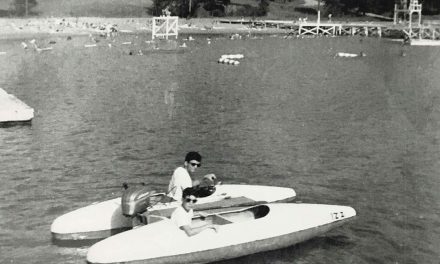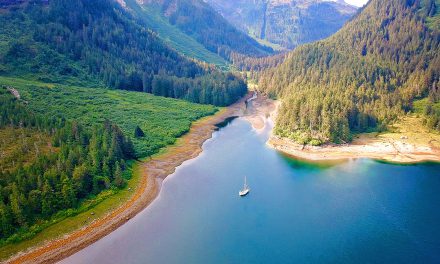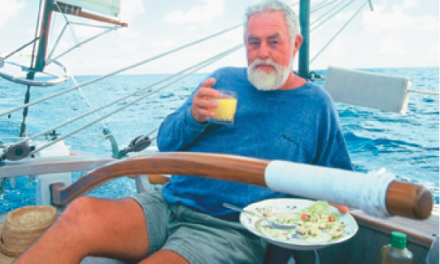A 600-mile trip on the Saint Lawrence proves an enjoyable test for a smaller new boat
Issue 149: March/April 2023

Salida 1 on Lac St. Louis, leaving Pointe-Claire early in the morning.
Big voyages in small sailboats have inspired me for as long as I can remember, being driven to accomplish more with less by balancing highly subjective trade-offs like simplicity and convenience.
Having recently downsized from a bluewater-proven Southern Cross 28 to a smaller, lighter, and shallower boat, I had the opportunity to exercise that notion on a 600-mile voyage along the mighty Saint Lawrence River between Montreal and Tadoussac. I’d sailed those waters before and knew it would be a good test for Salida 1, my newly acquired 1988 Bayfield 25.
The sailing plan was generally straightforward: Pointe-Claire to Quebec City with my brother, Christian, then on to Tadoussac and Rivière-du-Loup with my eldest son, Paul, and back to Pointe-Claire singlehanded. On top of numerous highlights during this four-week adventure, meeting up with friends from two other Pointe-Claire Yacht Club (PCYC) boats, as well as family along the way, added a whole other layer of satisfaction through sharing different aspects of the Saint Lawrence sailing experience.

Salida 1 heads through Canal de la Rive Sud
toward a railway lift bridge next to Pont Mercier.
Christian accompanied me on the first leg from Pointe- Claire to Quebec City, with a stopover in Sorel, a small city in southwestern Quebec. This took four days with very few engine hours, thanks to favorable currents and winds. We were spoiled with fine sailing, great anchorages, excellent meals, and as on previous trips, endless discussions about everything and nothing. Christian is a great storyteller and I almost drowned laughing from one of his stories while treading water at anchor in Trois-Rivières.
Following a crew change in Quebec City and an excellent dinner at Chez Muffy with my parents, who helped with crew transport, Paul joined me for the second leg to Tadoussac and Rivière-du-Loup. A choppy anchorage at Île de Bellechasse (a recurring theme from past trips), followed by strong winds and 6-foot waves the next day, led to a decidedly uncomfortable 24-hour start for Paul, who hadn’t yet gotten his sea legs.
Rather than risking an emergency stop at Parc Nautique Saint-Jean-Port-Joli, whose entrance is already treacherous at the best of times, we pressed on to Cap-à-l’Aigle as originally planned. Things started calming down as we approached the Saint Lawrence’s north shore, and we were even greeted by a curious beluga that came right alongside our boat.
The next day’s sail to Tadoussac was as pleasant as could be, with a 10-knot westerly under cool and sunny skies. It was my third time sailing to Tadoussac and will definitely not be the last. Tadoussac was founded in 1599 as a fur trading post and is now a quaint village of about 800 residents. Located at the confluence of the Saint Lawrence and Saguenay rivers in Quebec’s Charlevoix region, it has become a popular tourist destination for its picturesque setting, village restaurants and nightlife, abundant whale life, proximity to Saguenay Fjord National Park, and historical significance. As a sailing destination it ranks as one of my favorites, not only for all these reasons but also for its navigational challenges. Strong tidal currents and rips, combined with typically strong winds, fog, and busy whale-watching boat traffic, require careful planning and attention while underway. The water being just a few degrees above freezing also adds another element to sailing in this region, which to me is far from unpleasant, with cool days and even cooler nights.

An unusually busy lock in Basin Louise, preparing to enter Marina du Port de Quebec in Quebec City.
I’d decided to spend more time in Tadoussac on this trip, which proved to be a good call. Paul had never been there, and I wanted to share the town’s magic by spending three full days immersing ourselves in its charm. An avid hiker, Paul reveled in the chance to hike parts of the national park. It was worth every effort; the trails were beautifully maintained and the views of the two rivers were breathtaking. And there were plenty of bars, restaurants, and coffee shops to reward ourselves after each hike. We enjoyed freshly made croissants and espressos allongés (espresso with a longer shot than a traditional one) on an outdoor terrace overlooking the bay. One evening we had locally crafted beer on another terrace to celebrate a job offer Paul had just received, and as luck would have it, there were spectacular fireworks right there in front of us. What timing!
We also met up with our friend Maude and her family on their Southern Cross 28, Exilés (my previous sailboat), and had a pleasant dinner of fish and chips at the marina’s restaurant overlooking the bay. I enjoyed the very same meal on my two previous trips and was happy to share this emerging tradition with Maude and Guy and one of my sons. Aboard Salida 1 later with Maude and Guy, I finally opened the 10-year-old Talisker single malt scotch whisky I’d been saving for months to celebrate reaching this iconic destination.
After leaving Tadoussac, we headed southwest to Île-du-Pot-a-l’Eau de Vie (aka Brandy Pot Island) with Exilés. This lower Saint-Lawrence anchorage remains my favorite for its postcard-like setting, heritage lighthouse, and an impressive number of birds chirping endlessly — another wonderful experience to share. The next day Exilés set sail west to Saint-Jean-Port-Joli, while Paul and I headed for Rivière-du-Loup (RDL), a short 5 miles from our anchorage. As we approached RDL, a half-dozen curious belugas paid us a visit, diving under the boat and nosing around. One would occasionally rub against the rudder, making the wheel turn in response. I’ve never seen so many that close — a tad eerie at times, but quite exciting. The tide was dropping, so after half an hour of this meet-and-greet we had to get going, otherwise we’d be stuck in mud for hours just before reaching our assigned slip. We managed a dramatic escape and somehow made it in the nick of time.

Salida 1 stranded in mud at low tide. Luckily, the boat’s fenders protected the hull and there was no damage.
But not long after tying to our slip, Salida 1 sat in the mud, tilted at an uncomfortable 30-degree angle. The entire marina is in mud at low tide, but the boats normally just sink straight into the mudhole formed by their keel. Since there were no boats at our slip before we arrived, there was no preformed hole, which caused our boat to lean against the dock when the water ebbed. Thankfully, my fenders did their job protecting the hull and we managed to change slips around midnight on the rising tide. Success.
In RDL I finally caught up with my friend Robert, who was there with his Irwin 31, Tango 6. His family was camping nearby and Robert had sailed there from the PCYC. The plan was for Robert and me to each make our way back to Pointe-Claire singlehanded, with Robert accompanied by a family dog. But before our departure, my younger son, Sam, drove from Montreal with his girlfriend, Christine, to spend a day with us and then continue onward to Halifax. We all had a wonderful day, and our mini-putt game was a hit.
During that time, Maude was stuck with her family in Saint-Jean-Port-Joli with engine troubles and no one available to help. So Robert and I left a day earlier than planned to meet up with her, and favorable northeast winds helped us make it in one day. La Traverse Saint Roch is a Saint Lawrence channel known to be treacherous due to its relative shallowness and strong tidal currents. Although the wind was blowing in the same direction as the current, it was still a surprisingly rocky passage — especially at the marina’s tricky entrance, a narrow channel bounded by pillars of rocks that are perpendicular to the strong current and confused waves. Spectators are often perched atop cement walls near the entrance, looking on and enjoying a good show.

Fine sailing under the Quebec City bridges, propelled by a strong ebb current.
For the first time on this trip, all three PCYC boats were finally together. We wasted no time taking a look at Exilé’s engine. An electrical short had caused a fire on its approach to Saint-Jean-Port-Joli a few days before. We proceeded to rewire things, bypassing the alternator to keep it simple. As I called out wire colors from the engine’s electrical diagram, Robert boldly removed the old cabling bundle and rewired the basic pieces from scratch. A continuous source of rosé wine throughout the entire operation made everything smoother, and before long we had the engine running. Following a proper pizza and beer celebration that chilly evening on the marina’s picnic table, the three boats headed west to Quebec City at the crack of dawn the next day.
From Quebec City we proceeded to Trois-Rivières with overnight anchorages in the small towns of Portneuf and Batiscan along the way. While Portneuf is quite far from the river’s shore, Batiscan is right on the river and we were able to anchor within view of the town’s church steeple. Salida 1’s modest little Yanmar 1GM10 single-cylinder diesel engine fought tirelessly against the strong current but persevered without a hitch until I finally dropped anchor in the Saint-Maurice River. That evening we were rewarded with spectacular fireworks almost directly above us. Maude and Guy had to get going the following day due to work schedules, but Robert and I decided to stay in Trois-Rivières for a few more days before continuing west.

Family reunion on Salida 1 in Rivière-du-Loup, with the author’s sons Paul, left, and Sam, with his girlfriend, Christine.
I’ve sailed by Sorel numerous times in the past but never took the time to enjoy the Ste-Anne-de-Sorel islands. Not this time. Robert and I each dropped anchor between Île Plate and Îles aux Sables. I was born in Sorel and my grandfather took me on these waters often in his small motorboat. I was far too young to remember much, if anything, but it felt great being there again. Other than a maddening mosquito invasion one night, I couldn’t have asked for a more pleasant anchorage.
Following a 30-minute stop at Marina de Saurel for Salida 1 to pump out, refuel, and get new ice blocks, we proceeded toward Longueuil by taking our time anchoring at Île Saint-Ours, near the city of Lavaltrie, and Île Deslauriers, near the town of Varennes. These proved to be surprisingly quiet and pretty anchorages, despite being fairly close to Montreal. In Longueuil we both got slips at the old yacht club, where we were greeted by friendly staff. I chatted with one of the members, the owner of a Bayfield 29 whom I had sailed by while heading east a month earlier.
A few club members drove to meet us in Longueuil to accompany us through the Montreal locks and on to Pointe-Claire. My son Paul also joined us, so on that last day of the trip we had more crew to share the homestretch. Both boats arrived at PCYC at the same time on a Saturday in late August. Maude and Guy, who arrived the week before, joined us for cold beers and a lively trip debrief on the club’s terrace.

Quebec City harbor, with the historic Château Frontenac hotel in the background.
Overall, it was a wonderful trip with fine sailing, great anchorages, and superb company with whom I could share different facets of the Saint Lawrence. Although I had sailed these waters before, I now did so with a very different boat. Salida 1 proved to be a surprisingly comfortable and solid little coastal cruiser, sailing comfortably in most conditions, and though it is rockier than my previous boat, it felt sturdy in stronger winds and larger waves. I completed a more ambitious, mostly singlehanded 1,100-nautical mile adventure the following season, which reaffirmed the sturdiness of this little good old boat. No doubt there will be many more adventures aboard Salida 1.
Benoit Fleury lives in Pointe- Claire near Montreal with his wife, Liuyuan, and their African Grey parrot, Smokie. During the summer months he can be found sailing Salida 1, his good old Bayfield 25, somewhere along the mighty Saint Lawrence River. Over the years he has ventured across all parts of the Saint Lawrence with family and friends, from the Thousand Islands in Ontario to the Gaspé Peninsula and the more rugged Côte-Nord in eastern Quebec. He plans to spend more time exploring the Gulf of Saint Lawrence and many of its shores.
Thank you to Sailrite Enterprises, Inc., for providing free access to back issues of Good Old Boat through intellectual property rights. Sailrite.com





